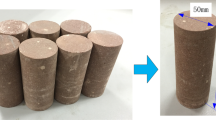Abstract
Transversely isotropic layered rock is widely distributed in nature. To better describe the time-dependent entire creep characteristics for transversely isotropic rock, a simple nonlinear damage creep model is derived based on fractional order theory, which consists of a Hooke elastomer, a fractional Abel dashpot, a fractional nonlinear damage dashpot, and can effectively describe the characteristics of primary creep, steady-state creep and accelerating damage creep. Assuming that Poisson's ratio is constant, the creep equation of isotropic rock is extended to transversely isotropic rock, and the nonlinear damage creep model for transversely isotropic rock is established. Step-wise loading triaxial creep tests of phyllite specimens with three kinds of bedding angles (0°, 45° and 90°) are carried out, and it is found that there are significant differences in creep deformation and failure characteristics under different bedding angles. The parameters of the creep model at each bedding angle are identified using the Universal Global Optimization method. By comparing the Nishihara model, the modified Nishihara model and experimental data, it shows that the creep model in this paper are highly consistent with the experimental data under different bedding angles, load levels and creep stages, and the accuracy and rationality of the model are verified.
Highlights
-
A simple nonlinear damage creep model is derived based on fractional order theory.
-
By assuming that Poisson's ratio is constant, the creep equation of isotropic rock is extended to transversely isotropic rock, and the nonlinear damage creep model for transversely isotropic rock is established.
-
There are significant differences in creep deformation and failure characteristics of phyllite specimens with different bedding angles.
-
Parameters of the proposed creep model at each bedding angle are identified by using the Universal Global Optimization, and the accuracy and rationality of the model are verified.

















Similar content being viewed by others
Abbreviations
- D :
-
Damage variable
- E :
-
Elastic modulus parallel to foliation plane
- E′ :
-
Elastic modulus perpendicular to foliation plane
- G′ :
-
Shear modulus perpendicular to foliation plane
- μ :
-
Poisson's ratio parallel to foliation plane
- μ ′ :
-
Poisson's ratio perpendicular to foliation plane
- m :
-
Smallest integer greater than β
- n :
-
Ratio of E' to E
- t :
-
Creep time
- t a :
-
Accelerating creep time
- θ :
-
Angle between loading direction and normal direction of bedding plane
- β :
-
Derivative order of visco-elastic body
- γ :
-
Derivative order of visco-plastic body
- η :
-
Viscosity coefficient
- η 1 :
-
Viscosity coefficient of visco-elastic body
- η 2 :
-
Viscosity coefficient of visco-plastic body
- η 3 :
-
Viscosity coefficient of the nonlinear viscous body
- λ :
-
Damage parameter
- σ :
-
Axial stress
- σ s :
-
Yield stress
- ε :
-
Axial strain
- ε e :
-
Elastic strain
- ε ve :
-
Visco-elastic strain
- ε vp :
-
Visco-plastic strain
- ε a :
-
Triggered strain of the accelerating creep stage
- σ x, σ y, σ z :
-
Axial stresses in global coordinate system
- τ yz, τ zx, τ xy :
-
Tangential stresses in global coordinate system
- ε x, ε y, ε z :
-
Axial strains in global coordinate system
- γ yz, γ zx, γ xy :
-
Tangential strains in global coordinate system
- E ω,ξ (x):
-
Mittag–Leffler function
- J(t):
-
Creep compliance
- Г(β):
-
Gamma function
- [A]:
-
Poisson's ratio matrix for isotropic rock
- [U]:
-
Poisson's ratio matrix for transversely isotropic rock
- [S]:
-
Flexibility matrix of global coordinate system
- [S ′]:
-
Flexibility matrix of local coordinate system
- [ε]:
-
Strain tensor of global coordinate system
- [ε′]:
-
Strain tensor of local coordinate system
- [σ]:
-
Stress tensor of global coordinate system
- [σ ′]:
-
Stress tensor of local coordinate system
- s ij :
-
Components of matrix [S]
- u ij :
-
Components of matrix [U]
References
Aliabadian Z, Zhao GF, Russell AR (2019) Failure, crack initiation and the tensile strength of transversely isotropic rock using the brazilian test. Int J Rock Mech Min Sci. https://doi.org/10.1016/j.ijrmms.2019.104073
Behbahani H, Ziari H, Kamboozia N (2016) Evaluation of the visco-elasto-plastic behavior of glasphalt mixtures through generalized and classic burger’s models modification. Constr and Build Mater 118:36–42. https://doi.org/10.1016/j.conbuildmat.2016.04.157
Cao WG, Chen K, Tan X et al (2020) A novel damage-based creep model considering the complete creep process and multiple stress levels. Comput and Geotech. https://doi.org/10.1016/j.compgeo.2020.103599
Chen YF, Wei K, Liu W et al (2016) Experimental characterization and micromechanical modelling of anisotropic slates. Rock Mech Rock Eng 49:3541–3557. https://doi.org/10.1007/s00603-016-1009-x
Chen ZQ, He C, Wu D et al (2017) Fracture evolution and energy mechanism of deep-buried carbonaceous slate. Acta Geotech 12:1243–1260. https://doi.org/10.1007/s11440-017-0606-5
Chen ZQ, He C, Xu GW et al (2019) A case study on the asymmetric deformation characteristics and mechanical behavior of deep-buried tunnel in phyllite. Rock Mech Rock Eng 52:4527–4545. https://doi.org/10.1007/s00603-019-01836-2
Chen G, Wan Y, Sun X et al (2021) Research on creep behaviors and fractional order damage model of sandstone subjected to freeze-thaw cycles in different temperature ranges. Chin J Rock Mech Eng 40:1962–1975
Cheng H, Zhang YC, Zhou XP (2021) Nonlinear creep model for rocks considering damage evolution based on the modified nishihara model. Int J Geomech. https://doi.org/10.1061/(asce)gm.1943-5622.0002071
Feng WL, Qiao CS, Niu SJ et al (2020) An improved nonlinear damage model of rocks considering initial damage and damage evolution. Int J Damage Mec 29:1117–1137. https://doi.org/10.1177/1056789520909531
Feng YY, Yang XJ, Liu JG et al (2021) A new fractional nishihara-type model with creep damage considering thermal effect. Eng Fract Mech. https://doi.org/10.1016/j.engfracmech.2020.107451
Gholami R, Rasouli V (2014) Mechanical and elastic properties of transversely isotropic slate. Rock Mech Rock Eng 47:1763–1773. https://doi.org/10.1007/s00603-013-0488-2
Gonzaga GG, Leite MH, Corthesy R (2008) Determination of anisotropic deformability parameters from a single standard rock specimen. Int J Rock Mech Min Sci 45:1420–1438. https://doi.org/10.1016/j.ijrmms.2008.01.014
Hou RB, Zhang K, Tao J et al (2019) A nonlinear creep damage coupled model for rock considering the effect of initial damage. Rock Mech Rock Eng 52:1275–1285. https://doi.org/10.1007/s00603-018-1626-7
Lakshmikantham V, Vatsala AS (2008) Basic theory of fractional differential equations. Nonlinear Anal-Theor 69:2677–2682. https://doi.org/10.1016/j.na.2007.08.042
Li CB, Wang J, Xie HP (2020) Anisotropic creep characteristics and mechanism of shale under elevated deviatoric stress. J Petrol Sci Eng. https://doi.org/10.1016/j.petrol.2019.106670
Li K, Yin ZY, Han D et al (2021a) Size effect and anisotropy in a transversely isotropic rock under compressive conditions. Rock Mech Rock Eng 54:4639–4662. https://doi.org/10.1007/s00603-021-02558-0
Li LL, Guan JF, Xiao ML et al (2021b) Three-dimensional creep constitutive model of transversely isotropic rock. Int J Geomech. https://doi.org/10.1061/(asce)gm.1943-5622.0002111
Lin H, Zhang X, Cao R et al (2020) Improved nonlinear burgers shear creep model based on the time-dependent shear strength for rock. Environ Earth Sci. https://doi.org/10.1007/s12665-020-8896-6
Liu W, Zhang S, Chen L (2021a) Time-dependent creep model of rock based on unsteady fractional order. J Min Safety Eng 38:388–395
Liu WW, Chen JX, Luo YB et al (2021b) Deformation behaviors and mechanical mechanisms of double primary linings for large-span tunnels in squeezing rock: a case study. Rock Mech Rock Eng 54:2291–2310. https://doi.org/10.1007/s00603-021-02402-5
Nomikos P, Rahmannejad R, Sofianos A (2011) Supported axisymmetric tunnels within linear viscoelastic burgers rocks. Rock Mech Rock Eng 44:553–564. https://doi.org/10.1007/s00603-011-0159-0
Pouragha M, Eghbalian M, Wan R (2020) Micromechanical correlation between elasticity and strength characteristics of anisotropic rocks. Int J Rock Mech Min Sci. https://doi.org/10.1016/j.ijrmms.2019.104154
Saroglou H, Tsiambaos G (2008) A modified hoek-brown failure criterion for anisotropic intact rock. Int J Rock Mech Min Sci 45:223–234. https://doi.org/10.1016/j.ijrmms.2007.05.004
Shen PW, Tang HM, Zhang BC et al (2021) Investigation on the fracture and mechanical behaviors of simulated transversely isotropic rock made of two interbedded materials. Eng Geol. https://doi.org/10.1016/j.enggeo.2021.106058
Shi XC, Yang X, Meng YF et al (2016) Modified hoek-brown failure criterion for anisotropic rocks. Environ Earth Sci. https://doi.org/10.1007/s12665-016-5810-3
Sun XM, Zhao CW, Tao ZG et al (2021) Failure mechanism and control technology of large deformation for muzhailing tunnel in stratified rock masses. Bull Eng Geol Environ 80:4731–4750. https://doi.org/10.1007/s10064-021-02222-5
Wang XG, Huang QB, Lian BQ et al (2018a) Modified nishihara rheological model considering the effect of thermal-mechanical coupling and its experimental verification. Adv Mater Sci Eng. https://doi.org/10.1155/2018/4947561
Wang ZC, Zong Z, Qiao LP et al (2018b) Elastoplastic model for transversely isotropic rocks. Int J Geomech. https://doi.org/10.1061/(asce)gm.1943-5622.0001070
Wang ZC, Zong Z, Qiao LP et al (2018c) Transversely isotropic creep model for rocks. Int J Geomech. https://doi.org/10.1061/(asce)gm.1943-5622.0001159
Wang XK, Xia CC, Zhu ZM et al (2021) Long-term creep law and constitutive model of extremely soft coal rock subjected to single-stage load. Rock Soil Mech 42:2078–2088
Wu F, Liu J, Zou QL et al (2021) A triaxial creep model for salt rocks based on variable-order fractional derivative. Mech Time-Depend Mat 25:101–118. https://doi.org/10.1007/s11043-020-09470-0
Xu GW, He C, Chen ZQ et al (2020) Transversely isotropic creep behavior of phyllite and its influence on the long-term safety of the secondary lining of tunnels. Eng Geol. https://doi.org/10.1016/j.enggeo.2020.105834
Xue D, Lu L, Yi H et al (2021) A fractional burgers model for uniaxial and triaxial creep of damaged salt-rock considering temperature and volume-stress. Chin J Rock Mech Eng 40:315–329
Yan BQ, Guo QF, Ren FH et al (2020) Modified nishihara model and experimental verification of deep rock mass under the water-rock interaction. Int J Rock Mech Min Sci. https://doi.org/10.1016/j.ijrmms.2020.104250
Zhou HW, Wang CP, Han BB et al (2011) A creep constitutive model for salt rock based on fractional derivatives. Int J Rock Mech Min Sci 48:116–121. https://doi.org/10.1016/j.ijrmms.2010.11.004
Acknowledgements
This research was supported by the High Speed Railway and Natural Science United Foundation of China (No. U1734205), the Transportation Science and Technology Project of Sichuan Province, China (No. 2019ZL09), and CSCEC Technology R & D Plan of China (No. CSCEC-2021-Z-26).
Funding
This research was supported by the High Speed Railway and Natural Science United Foundation of China (No. U1734205), the Transportation Science and Technology Project of Sichuan Province, China (No. 2019ZL09), and CSCEC Technology R & D Plan of China (No. CSCEC-2021-Z-26).
Author information
Authors and Affiliations
Corresponding author
Ethics declarations
Conflict of interest
The authors declare that we have no conflict of interest.
Additional information
Publisher's Note
Springer Nature remains neutral with regard to jurisdictional claims in published maps and institutional affiliations.
Rights and permissions
Springer Nature or its licensor (e.g. a society or other partner) holds exclusive rights to this article under a publishing agreement with the author(s) or other rightsholder(s); author self-archiving of the accepted manuscript version of this article is solely governed by the terms of such publishing agreement and applicable law.
About this article
Cite this article
Kou, H., He, C., Yang, W. et al. A Fractional Nonlinear Creep Damage Model for Transversely Isotropic Rock. Rock Mech Rock Eng 56, 831–846 (2023). https://doi.org/10.1007/s00603-022-03108-y
Received:
Accepted:
Published:
Issue Date:
DOI: https://doi.org/10.1007/s00603-022-03108-y




